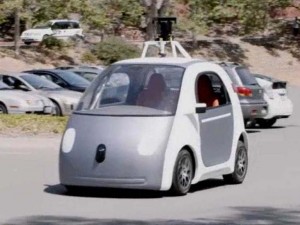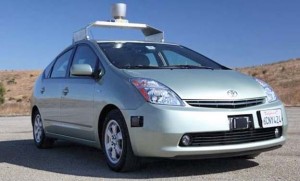
Looking a bit like a cross betwen an old Beetle and a Smart Fortwo, Google will produce 100 of these autonomous prototypes this year.
Google will build 100 prototypes of its self-driving cars as the next step in plans to make autonomous driving a common feature on American roads in the not-too-distant future.
The high-tech firm has been one of the leaders of the effort to move autonomous driving out of the realm of science fiction and transform it into a day-to-day reality. Google’s announcement could put it ahead of automakers such as Nissan which has promised to put its own self-driving vehicle into production by 2020.
The Google autonomous prototypes won’t be sold to the public, however. They will be used to prove out the technology the firm is developing. But they offer a glimpse of what could come much sooner than many experts had anticipated only a few years ago and will be distinctly different from even today’s most technologically advanced vehicles in several key ways – among them the lack of a steering wheel.
After driving one of the prototypes, Google co-founder Sergey Brin told a tech conference, “It reminded me of catching a chairlift by yourself, a bit of solitude I found really enjoyable.”

California-based Google already operates a fleet of prototype autonomous vehicles using modified conventional cars like this Toyota Prius.
Much of the basic technology that will be used in tomorrow’s autonomous cars – such as radar, laser and sonar sensors — already can be found on today’s vehicles. The key challenge is coming up with the computational algorithms, the software required to pilot a vehicle through the complicated decisions needed to handle thick traffic and unusual intersections.
Google, however, has logged 10s of thousands of miles with its earlier “mules,” conventional vehicles modified to drive autonomously.
There is an ongoing debate over precisely what sort of vehicles will reach market first. Some experts – and some major carmakers – are betting that the initial focus will be on vehicles that can assist the driver who will remain in control. But Google is among those who want to hand off driving duties entirely, said Chris Urmson, director of the firm’s autonomous vehicle project.
“Ever since we started the Google self-driving car project, we’ve been working toward the goal of vehicles that can shoulder the entire burden of driving,” Urmson said.
(Study finds nearly 90% of Americans “worried” about driving in autonomous vehicles. Click Here for the story.)
The launch of the new prototypes, which have been designed specifically for autonomous driving, takes the project to a new level, he noted in a blog post.
“We’re now exploring what fully self-driving vehicles would look like by building some prototypes; they’ll be designed to operate safely and autonomously without requiring human intervention. They won’t have a steering wheel, accelerator pedal, or brake pedal… because they don’t need them,” he said.
Urmson said the vehicles will be very basic, with few creature comforts. And their speed will be capped at just 25 mph.
“On the inside, we’ve designed for learning, not luxury, so we’re light on creature comforts, but we’ll have two seats (with seatbelts), a space for passengers’ belongings, buttons to start and stop, and a screen that shows the route—and that’s about it,” he explained.
The first prototypes will be built this summer, initially with manual controls to build confidence. Testing should begin by autumn.
(What to do inside an autonomous vehicle? Rinspeed’s XChangE concept offers options for travelers to pass the time. Click Here for a closer look.)
Prototype vehicles can cost as much as $1 million apiece to build because they’re assembled by hand, which means Google could be sinking as much as $100 million into the project.
“If all goes well, we’d like to run a small pilot program here in California in the next couple of years. We’re going to learn a lot from this experience, and if the technology develops as we hope, we’ll work with partners to bring this technology into the world safely,” he said.
One of the challenges will be ensuring that the vehicles actually can be legally operated on the street. Several states, including Nevada and Michigan, already have enacted laws permitting testing of autonomous vehicles – but they require a licensed driver to be sitting behind the wheel to take control in an emergency. It’s unclear how the Google vehicles, without a steering wheel, would be accepted.
California is in the process of developing its own licensing policies for autonomous prototypes and officials say the Google project will force them to move more quickly than they originally planned.
(For more on California’s efforts to craft autonomous vehicle guidelines, Click Here.)
Virtually every major automaker is now working on autonomous vehicle technology. The United Nations even stepped into the discussion this past week with a clarification of a global treaty that some thought might restrict hands-off driving.
Studies show significant interest in the technology, but also plenty of skepticism among the drivers who might someday be offered self-driving cars. But Google’s Urmson believes they’ll be sold by the potential advantages.
“You can take a trip downtown at lunchtime without a 20-minute buffer to find parking,” he said. “Seniors can keep their freedom even if they can’t keep their car keys. And drunk and distracted driving could become a thing of the past.”
With Google producing its own vehicle prototypes, some have begun to wonder whether the well-funded firm might actually want to enter the automotive business. So far, Google has only indicated it would like to find a traditional automaker interested in partnering with it.
“As vehicles become more technology dependent, it makes sense that Google is interested in participating the automotive category,” said Jared Rowe, President of Kelley Blue Book. “Google will have a lot to learn about automotive manufacturing if they do end up wanting to become a mainstream brand, however, they have the resources necessary to succeed if they put the full weight of their resources toward it. But only time will tell, as we need to make sure that autonomous driving technology works and we can feel safe – inside and outside of the vehicle.”
(Paul A. Eisenstein contributed to this report.)
